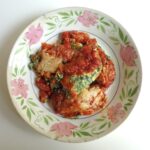 Storzapretti are Corsican dumplings made with spinach or chard and cheese, topped with tomato sauce and more cheese, and baked until bubbly and golden. According to legend, a priest once found the dumplings so delicious that he stuffed himself to the point of choking, hence their name, which translates roughly as ‘strangle the preacher’. One might think they’d be heavy, but after eating a plateful my guest pronounced them delightfully light.
Storzapretti are Corsican dumplings made with spinach or chard and cheese, topped with tomato sauce and more cheese, and baked until bubbly and golden. According to legend, a priest once found the dumplings so delicious that he stuffed himself to the point of choking, hence their name, which translates roughly as ‘strangle the preacher’. One might think they’d be heavy, but after eating a plateful my guest pronounced them delightfully light.
Storzapretti / Corsican dumplings in tomato sauce
I stumbled upon this recipe during a recent trip to Corsica, known by the French as l’Île de Beauté (the Isle of Beauty). And it is incredibly beautiful. White sand beaches, pale turquoise waters, charming villages nestled in mountains rising just inland from the sea, parasol pines, flowers everywhere. Seafood is plentiful, the veggies are gorgeous and local specialties include brocciu, a fresh cheese similar to ricotta made of sheep or goats milk.
One of the island’s signature dishes is cannelloni au brocciu, in which the tubular cannelloni are stuffed with a mixture of brocciu and Swiss chard. Storzapretti are like cannelloni au brocciu minus the cannelloni. There is a bit of potato, making them somewhat akin to gnocchi, but they are far lighter and fluffier. As brocciu can be hard to find outside Corsica, and even in Corsica has a season, ricotta may be used instead.
Upon returning from Corsica I did a little research and discovered that the dumplings have roots in the Trentino region of Italy (and, as my Italian friends like to point out, Corsica was ruled by the Italians long before it became part of France). I also discovered that, within Corsica, the dish is a regional specialty, the region being the north of the island and in particular the area around the city of Bastia. When I asked a Corsican friend about the dish, she’d never heard of it — her family’s place is further south.
The name itself is problematic. According to Laure Verdeau, whose grandmother was from Bastia and who wrote about storzapretti recently for M, the magazine of Le Monde, the name translates from Corsican into French as étouffe-prêtre, or ‘choke the priest’. Other sources translate the name as tordre le moine (‘twist the monk’) or presser le moine (‘squeeze the monk’). But if etymology can be a guide, then the Italian version, strangolapreti, resolves the argument. It very clearly means ‘priest stranglers’.
The Italian dish differs from the Corsican version, however. My favorite Italian recipe site describes strangolapreti as ‘a truly ancient dish of truly special gnocchi made with stale bread and spinach’. No potato and no fresh cheese. The herbs are also different. The Corsican dumplings are flavored with mint and parsley, the Italian with fresh sage. And the Italian dumplings are served with melted butter — no tomato sauce involved.
This being said, the cooking of the dumplings is similar. You make a batter, form oval shapes, dust them with flour and drop them into boiling water until they fluff up and rise to the surface. This is the fun part of the recipe, which is admittedly a bit more of a production than most of the recipes on this site. But you can do it in stages, for example by making the tomato sauce the day before embarking on the dumplings themselves.
The storzapretti may be served either as a vegetarian main course or starter, or as a side dish with grilled or roasted meat, fish or poultry. You could begin with, say, melon and prosciutto and follow up with fresh summer fruit or a fruity dessert. Either a chilled rosé or a dry red would marry well. You might just feel like you’re on a beautiful island…
Happy cooking.





The cooked potatoe is added before refrigerating?
William, yes! Good catch. The mashed potato should be added to the batter along with the spinach or chard, etc. I neglected to mention that when I posted the recipe on Friday. Thanks to you, the recipe has now been updated. All best and happy cooking, Meg
Strozzaprieti, non?
Hi, good question. Answer: both yes and no! No because the word ‘strozzapreti’ is mainly used to denote a kind of fresh hand-rolled pasta that looks something like twisted macaroni. Yes because, according to the Wikipedia page on the subject, ‘strozzapreti’ can refer either to that type of fresh pasta or to various types of gnocchi — including the Corsican version, storzapretti! I can’t seem to add a link to that page in this comment, but if you check it out you’ll see photos and descriptions of the very many forms these ‘priest stranglers’ can take.